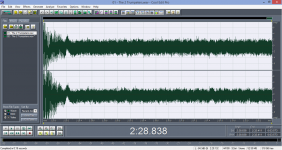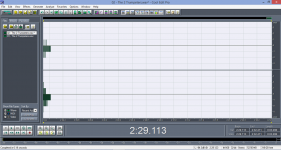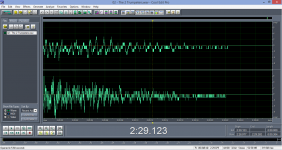Well, I wish I could learn as much from you guys, as you can from me, but I have not found it so, over the last 15 years or so. I am addressing the real audio engineering pros out there, many of whom do not daily contribute. I would hate to miss a very high quality textbook on audio design by accident, because I did not ask. I am still designing new products, and I need new ideas.
Hi John,
That's the thing. You can learn something from sources you didn't expect to get anything from.
Actually John, you sometimes do really teach something that we can learn from, but those instances are often buried in nonsense filled exchanges - like Bybee for example. You might believe that stuff works, but you might also be doing yourself a big favour by not mentioning that product line. Just think of how much easier that might be.
Just saying ...
-Chris
That's the thing. You can learn something from sources you didn't expect to get anything from.
Actually John, you sometimes do really teach something that we can learn from, but those instances are often buried in nonsense filled exchanges - like Bybee for example. You might believe that stuff works, but you might also be doing yourself a big favour by not mentioning that product line. Just think of how much easier that might be.
Just saying ...
-Chris
Well, I wish I could learn as much from you guys, as you can from me, but I have not found it so, over the last 15 years or so. I am addressing the real audio engineering pros out there, many of whom do not daily contribute. I would hate to miss a very high quality textbook on audio design by accident, because I did not ask. I am still designing new products, and I need new ideas.
I don't have the Cordell book or any of Self's books, though recall seeing his "Distortion in Power Amplifiers" page at least 20 years ago, and learning some interesting stuff from that. I never expected to find myself designing audio for a living, though perhaps I should have gotten more of these books as a "hobby." In 2000 I did complete my back issues of Audio Amateur and Speaker Builder, and that was all good reading, though I regret not actually building more that I have.
I recently found this, a recent general electronics textbook. I don't know its status, but I don't see it (this second edition) for sale anywhere (and only a very few used copies of the first, titled "Analog Electronic Circuit Design" - I suspect it was self-published and sold few copies), so I'm thinking it's okay to post a link:
https://www.sphere.bc.ca/download/analog-circuit-design-hiscocks.pdf
It's interesting in that it shows a lot of practical detail that the usual AC circuits analysis texts never did (partly because of their limited scope, but even then). It also covers transistors, op-amps, various types of active filters, and audio power amps. (Yeah, all that adds up it's 1100 pages.) There's little if anything I don't already know, but it's fun to go over it and think "wow, if I only had THIS in college" because it has so many things that many of us learned through experience, or at best, in Bob Pease's columns.
If I WERE to be hired to design audio electronics, no doubt it would be to use the latest TI Class D chips in home/car surround sound systems. There's even a plant that designs and makes car radios south of Atlanta ...
Just wondering if that (bold) really is a censored word...Bonobos are even closer. Unlike regular chimps, they **** face to face, they have stress-relief sex, make-up sex and random hook-up sex, 60% of females are dykes.

Thanks Benb, that is exactly what I was looking for. I hope that others download your book selection as well.
Quote:
Pavel (or anybody), I am starting with 16 bit file that needs to be converted to 24bit, I asked and I got the answers as above, but no detail on what to do and how to do it, and then Mark4 stated that I am converting correctly..
Are you saying that I need to add dithering/noise/information to the 16bit file when upscaling to 24bit ?.
If so please advise me on how to do so in order to ensure correct experiment.
Pavel, how about you help here and explain how to convert 16bit to 24bit please.Something amateurishly erroneous and mistaken, in the latest test. It may be the SW issue as well (no dither, 24bit reduced to 16bit, though he probably does not realize).
Dan.
I don't have the Cordell book or any of Self's books, though recall seeing his "Distortion in Power Amplifiers" page at least 20 years ago, and learning some interesting stuff from that. I never expected to find myself designing audio for a living, though perhaps I should have gotten more of these books as a "hobby." In 2000 I did complete my back issues of Audio Amateur and Speaker Builder, and that was all good reading, though I regret not actually building more that I have.
I recently found this, a recent general electronics textbook. I don't know its status, but I don't see it (this second edition) for sale anywhere (and only a very few used copies of the first, titled "Analog Electronic Circuit Design" - I suspect it was self-published and sold few copies), so I'm thinking it's okay to post a link:
https://www.sphere.bc.ca/download/analog-circuit-design-hiscocks.pdf
It's interesting in that it shows a lot of practical detail that the usual AC circuits analysis texts never did (partly because of their limited scope, but even then). It also covers transistors, op-amps, various types of active filters, and audio power amps. (Yeah, all that adds up it's 1100 pages.) There's little if anything I don't already know, but it's fun to go over it and think "wow, if I only had THIS in college" because it has so many things that many of us learned through experience, or at best, in Bob Pease's columns.
If I WERE to be hired to design audio electronics, no doubt it would be to use the latest TI Class D chips in home/car surround sound systems. There's even a plant that designs and makes car radios south of Atlanta ...
Peter Hiscocks was a professor of EE at Ryerson University in Toronto, from the 70’s until the early 2000 when he retired from teaching. He passed away in 2018. Ryerson is a good university, but not exactly Ivy League material.
The book is his teaching legacy, nothing more or less.
CMOS design, layout, and simulation R Jacob Baker. Mostly IC design but some interesting circuits and insight into them.
John, when are you going to write your own book on audio design? It immediately would become a bestseller. Just look at the number of pages this thread have generated. Think about it! Best,Thank Anatech for responding. At your economic level, I am not surprised that analog design textbooks would appear to be an unnecessary extravagance, but I still design audio for a living, so I can write them off, AND I still need to keep up, and SOMETIMES, I learn something new from one of these textbooks, so they are worth it, even if it is just one or two novel concepts. I am still hoping that someone here who reads this tread has found some textbook, even one for free online, that they have found extra valuable, and will suggest it.
Dan, I haven't followed your tests and I forgot what they were all about, but let me try. It all depends on what software you have available. If it's some kind of audio editor then just open the 16 bit file and then immediately save it as ('save as' command) 24 bit (WAV, AIFF, BWF etc) file. If your software's code isn't broken (yes, it happens) then you will have your 16 bit data in a '24 bit 'container' so to speak with lower bits padded as zeros. Simple as that. Also, check your software's preferences and make sure that dither, normalize or something similar is not set somewhere as option when exporting or saving. Feel free to ask any questions. I hope that I can help...how about .. help here and explain how to convert 16bit to 24bit please.
[edit] Before conducting any experiments, one ought to test the tools used in that experiment. As someone once said: "Never turn your back to digital!" 😉 [edit 2] If you can't handle the files by yourself, just point me to the originals and I'll do it for you. I have all sorts of tools available.
This is not the case. File "01" is a 24bit file - saved as 24bit file and has 24bit resolution, that means there are amplitude levels smaller than the least 16th bit. File "02" is saved as 24bit, seems to be 24bit, but the resolution is only 16bit and there is nothing smaller than the 16th bit LSB and worse, there is no dither on those in fact 16bit data. Scott tried to explain this, I am trying to explain this but it is not understood by the receiver. This is annoying and probably better not to try to participate.
Images attached, again. Pears and apples are compared, then.
Images attached, again. Pears and apples are compared, then.
Attachments
And, the problem of time and distance may turn out to not be a limitation to communication or even travel. In our lifetime no challenge to Einstein's classical view of, you know, Life, the Universe, and Everything, seems possible, but in Einstein's lifetime things were more fluid. His proposed EPR paradox was later confirmed by Bell, and then others, to actually be a violation of classical physics, of which Einstein was the last and the greatest thinker.Someone (Freeman Dyson? I can't remember) once said that when it comes to the BIG questions like extraterrestrial life, thare are just three significant numbers: 0, 1, and infinity. That is, one can conceive of a universe with no planets like ours and no life as we know it. Of course we exist, so that's off the table. One can also conceive of a universe where just one, unique planet with life exists, for whatever reason (wink wink). However, if you can identify even one other case, then, given the sheer numbers, there are effectively an infinite number of such planets.
Spooky action at a distance is provable and observable, but we have currently no Einstein to explain it. There are a lot of smart people in the world, so someday we will have a theory that encompasses it, leading to information moving faster than light. Discussions of galactic+ dimensions need long-term viewpoints, although it's very hard to get past our inherently parochial nature. Just the way we're made.
All bets are off if some dangerous clown melts the place first. (The dark side of the Drake equation.)
All good fortune,
Chris
What's straight up jazz? I always thought Ornette was pretty unique 🙂That’s good stuff.....I usually don’t like straight up jazz but that’s got some soul!
which means it's the 16-bit original saved as 24-bit. Two of the files in the set must be like that, obviously.... but the resolution is only 16bit and there is nothing smaller than the 16th bit LSB ...
Normally, for playback there's no need to convert a 16bit file.
The only need for this comes from preventing very simple cues which file is which, by sheer file size.
We already spoke about it - Audacity free version often changes resolution down to 16bit, though saving the file in 24 bit format. The Audacity files have to be inspected before use. It is better to use another SW, like Adobe Audition, Cool Edit Pro, ......, you name it.
Ah, ok. I never use Audacity so I can't comment.
For the simple stuff like conversions SOX command line tool is best and most simple to use.
E.g. convert 16 to 24 : sox -D infile.wav -b 24 outfile.wav
For the simple stuff like conversions SOX command line tool is best and most simple to use.
E.g. convert 16 to 24 : sox -D infile.wav -b 24 outfile.wav
Doesn't mean that an alternative to photosynthesis doesn't exist.
It does, on earth.
There is a collection of JC posts entitled "Condemnation without Examination is Prejudice or Words Of Wisdom by John Curl - May 2006" which is interesting and educational account of where JC comes from, where he has been and his findings, a uniquely great resource sadly now 15 years out of date, no doubt JC has said more since then that should be added and I give unbounded thanks to the author* for this considerable effort. (* I forget who it was).John, when are you going to write your own book on audio design? It immediately would become a bestseller. Just look at the number of pages this thread have generated. Think about it! Best,
There are so many ongoing posts here on this forum full of rudeness and even contempt aimed at JC, if these posters were to read this 150 page document they might learn some humbleness and give greater credit to one of the pioneers of high quality audio, and in the process learn much about electronic audio that is not covered in other texts.
I also give thanks to Jocko for hosting this document and making it available to all, an act of great generosity of spirit and in the name of advancement of audio.
Dan.
I wonder if some who are interested in audio are musicians, or frustrated musicians, and whether this sometimes influences their desire to design an audio chain which does more than faithfully reproduce the recording. I remember JC saying he is and perhaps it could be the case. Nelson Pass famously considers himself to be part of the entertainment industry. So it depends what you mean by advancement in audio, what about Bruno's latest offerings, and where are the advancements to be made?
- Status
- Not open for further replies.
- Home
- Member Areas
- The Lounge
- John Curl's Blowtorch preamplifier part III



